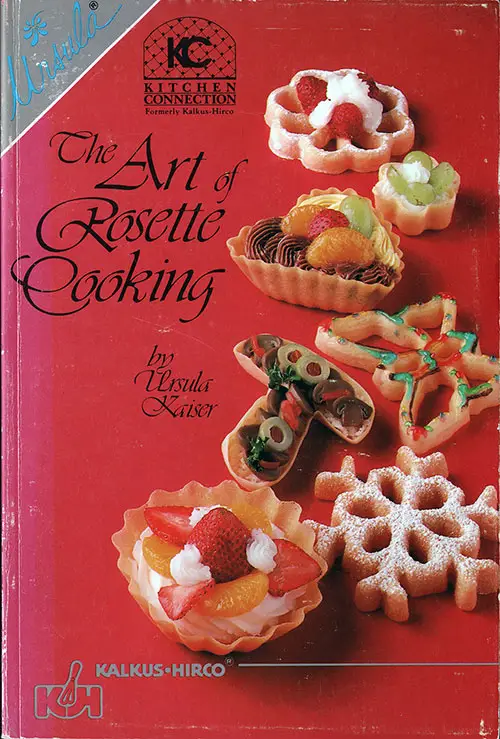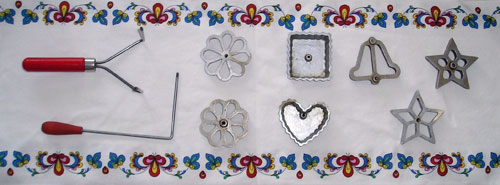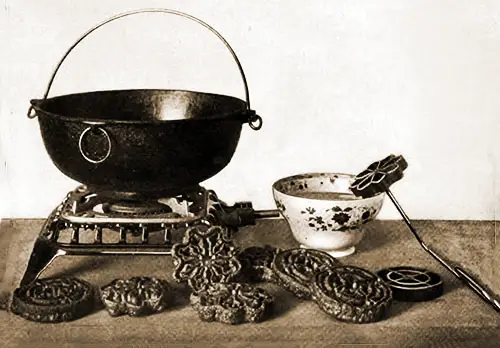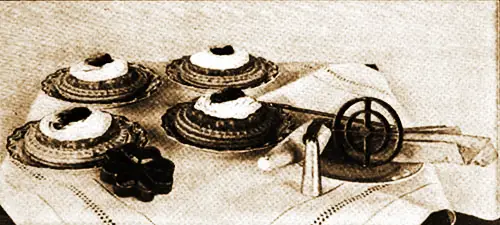Rosette Cookies and Vintage Recipes

Front Cover, The Art of Rosette Cooking by Ursula Kaiser, Published by Kalkus-Hirco. | GGA Image ID # 1fe5abe9ae
Rosettes are delicate but incredibly delicious Norwegian (or Swedish) cookies that have been a treat for many generations. Rosette cookies are as pretty as they are rich and delicious.
They are typically made only during the holidays as the preparation is time-consuming.
The original recipe called for deep frying in lard, but we recommend Extra Virgin Olive Oil as an acceptable and healthier substitution.
This recipe is what the Gjenvick family has used for generations in creating these most delicious but fragile cookies.
The Pastry is formed by dipping molds into a special batter and deep frying it to a crisp, flaky texture. The Rosette name comes from the basic geometric shape of the oldest molds — a circle crisscrossed with arcs to form a flower-like pattern.
The famous Rose Window in the Notre Dame Cathedral is a rosette shape. It was a prevalent shape in the early days of iron moldings. This shape was used to decorate gates, buildings, furniture, and especially festive foods.
The Christmas Season was when Norwegian grandmothers performed a kitchen ritual the children loved:
- For flavor, a simple batter was made with flour, eggs, sugar, salt, and a little vanilla.
- Oil was heated in a deep pan, and the magic began. A rosette iron was attached to the end of a long handle and dipped into the oil to preheat.
- The iron was dipped into the batter, so none went over the top.
In a few seconds, the iron was removed, with batter clinging perfectly to the shape. The batter and iron were then dipped into the hot oil. In a few more seconds, the rosette molds turned golden brown. Then, they came off with tongs to drain and cool on a paper towel. With a bit of powdered sugar sprinkled on top, they were terrific! (1)
Ingredients
- 2 eggs
- 1 teaspoon of sugar
- 1/4 teaspoon of salt
- 5 drops of pure vanilla extract
- 1 cup milk
- 1 cup flour
- Confectioners Sugar
Prerequisites
- Minimum of 16 fluid ounces of Extra Virgin Olive Oil, Peanut Oil, or Safflower Oil
- Rosettes Irons (minimum of two recommended)

An Example of the Different Types of Rosette Irons and Molds Typically Available. Nordic Ware Manufactured These Sets. | GGA Image ID # 1fe4a73d45
Making the Batter
Break eggs into a bowl, and add sugar, salt, vanilla, milk and flour. Beat ingredients until the mixture is well blended. Do not overbeat; mixing too much makes the rosettes blistered and tough.
Directions
In a deep kettle or large pot, heat your oil to 350 and 375 degrees.
Put the rosette irons into the hot oil so that they are hot before you dip into the batter mixture.
Dip your rosette iron into the batter, being careful not to go above the edge of the form.
Quickly place the iron in the hot oil, submerging the rosette completely.
Fry until evenly browned.
Remove the deep-fried rosette onto a cooling rack and carefully remove the rosette form assisted by a fork.
Carefully flip the rosette so the form is right side up, and repeat the process until the batter is used up (about 45 rosettes).
Once they have cooled, use a sifter to shake a light coating of confectioner sugar on top of the rosettes.
Store in an air-tight plastic container.
Summary
- Prep time: 45 minutes
- Cook time: 02:30
- Total time: 3:15
- Yield: Approximately 100 Rosettes
Problems with Rosettes?
- Rosettes don't come off of the iron.
- They are likely undercooked - they should be a golden brown color when they are done. Also, if you dip the iron in the batter over the top, it will be difficult to remove without breaking the rosette.
- Blisters are forming on the rosettes.
- The batter has been over-mixed (beaten)
- Rosettes drop off from Rosette iron while deep-frying.
- This typically happens when you don't have the irons placed low enough in the oil. Be sure that they are fully submerssed into the oil when deep frying.
- Rosettes are not coming out crisp.
- our oil is too hot. Reduce the temperature of the oil and continue.
General Instructions And Important Hints
Cooking Utensils:
- An electric-controlled pan is recommended (350°—375°).
- The pan should be deep enough to allow the mold to be completely submerged.
- Use a small deep pan for deep molds; you will use less oil.
- Use a thermometer to check degrees, even when using electric pans. (350°—375°) 1" cube bread browns in one minute.
Oils: Any good quality cooking oil will work.
- Peanut Oil and Safflower Oil have fewer calories.
- Heat oil to 365° before dipping shells or molds.
- Keep the temperature at 350°—375°; if the temperature is too low, the pastry gets soggy and greasy. (Use a thermometer to test: 1" cube of bread browns in one minute.)
Molds:
- Preheat molds for about 10 seconds.
- Drain slightly on paper toweling before dipping into batter.
- Keep molds free from crumbs and bits of batter.
- No batter should be on top of the mold.
- Dip the batter-filled mold into hot oil and submerge quickly before releasing.
- Use fork tine or tongs for turning; be careful not to prick.
- Allow deep molds to rest on the bottom of the pan for a second to ensure a flat surface.
- Wash molds with detergent after each use to keep them from becoming rancid.
Rosettes with Pineapple Shown with Rosette Irons and Pastry Bag. | GGA Image ID # 1fe5dcabff
Angel Parfait with Scandinavian Rosettes
Boil one cupful of sugar and one-third of a cupful of hot water to a thread. Heat the whites of two eggs light and add the syrup in a slow stream, beating steadily until a meringue is formed.
Let this cool. Fold in two capfuls of cream beaten solid, then turn into a mold previously wet with cold water. Cover carefully, pack in ice and salt for two. three or four hours. Serve on the rosettes garnished with strawberries.
Alternative Finishing Touches to Rosettes
Whether the rosettes are to be eaten with a fork or from the hand depends mainly upon the nature of the "filling" used. A rosette sprinkled with cheese, or a compact mixture, would be eaten from the hand. One dressed in preserves or whipped cream would be listed with pie and treated accordingly.

Scandinavian Rosettes. Photo by The Boston Cooking School Magazine, 1902. | GGA Image ID # 1fe5e61483
For Parties and Afternoon Teas
If you are fond of cooking and like to make things to eat attractive to the eye, get a rosette iron. Then, you can make rosettes that everyone will enjoy.
The following recipe will make four dozen:
- 1 cup sweet milk
- 1/4 teaspoonful salt
- 1 cup pastry flour
- 2 tablespoonfuls sugar
- 2 eggs
Break the eggs directly into the milk. Sift the sugar, flour, and salt and add this a little at a time to the milk mixture. Put the whole batter through the flour sifter, preventing lumps and making a perfectly smooth mass filled with air bubbles. A tablespoonful or two more milk may be added if it is too thick.
Put the lard over the fire to heat in a deep, not-too-large dish— the top of the double boiler is suitable. Have the fat hotter than for doughnuts — for doughnuts; it should just give off a blue haze; for rosettes, it wants to be about two degrees hotter than that.
Dip the iron into the hot lard and let it stay there until it is heated. Now dip it into the batter, being careful not to let the batter come over the top of the iron, as that will prevent the rosettes from slipping off.
Now dip the batter-covered rosettes quickly into the hot lard and out again. Only a few seconds are required to fry them. They are crisp and delicious and especially suitable for parties or afternoon teas.
They are so different from the ordinary cakes and cookies that they sell readily, and they are so pretty that they add to the attractiveness of any table.
Frying Scandinavian Rosettes
Beat four eggs without separating them. Add one pint of milk and stir gradually into three cups of flour, sifted with half a teaspoonful of salt and two tablespoonfuls of sugar. Beat very thoroughly when half the liquid has been added.
The eggs might be added with half the milk, as all the milk may not be needed. Heat the rosette iron in hot oil. Dip into the batter to half its height, and return to the hot oil until the cake is cooked a delicate brown.
Shake the iron onto soft paper. Serve, sprinkled with powdered sugar, as a dessert dish, or spread the rosettes with jam or preserves and ornament with whipped cream.
The batter should stand an hour after being mixed before the rosettes are fried. In winter, it may be kept for days and used as occasion requires, either for this or other purposes, to coat quarters of banana for frying.
(1) Excerpt from The Art of Rosette Cooking by Ursula Kaiser.

